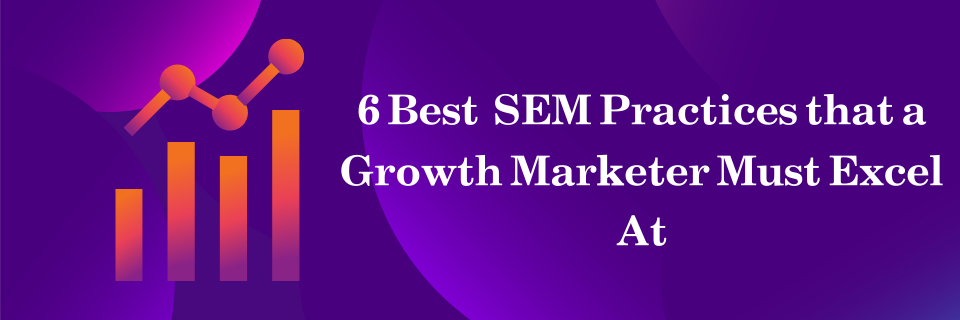Growth Marketers Must Master These 6 SEM Best Practices

6 best SEM practices that a Growth Marketer must excel at...
For optimal results from your paid search efforts, adhere to these six growth marketing principles. Although "growth hacking" and "growth marketing" are often used interchangeably, the former has its own job titles and responsibilities. So, what exactly does "growth marketing" entail? Essentially, it involves identifying and attracting the right customers for your business, whether they're at the top or bottom of the funnel, who are most likely to make a purchase. In today's landscape, what is the key to successful growth marketing? It's Search Engine Marketing (SEM), which should not be confused with SEO or PPC. SEM is a long-term strategy that consistently yields positive results in attracting qualified customers. To achieve success in SEM today, there are six best practices to follow.
1. Deliver Value Across The Decision Journey
Your growth marketing strategy should adapt to the changing behavior of your diverse clientele.
Have you ever wondered who's behind all those clicks? According to Microsoft Ads research, buyers go through five key stages of purchase intent:
First, they gather background knowledge and explore the purchasing landscape. This involves looking at buying guides, recommendations, and products that meet their fundamental criteria.
Next, they compare a few products that match their requirements, such as ratings, reviews, features, and price.
Then, they search for where to buy the product, looking at pricing, availability, specials, and nearby stores before making a purchase.
Even after making a purchase, customers may still come across products or services you offer in new regions and maintain their relationship with your brand.
Finally, happy customers may expand your reach by writing reviews, telling their friends about your brand, and progressing to the awareness stage.
2. Align Your Campaign & Business Goals
Your business goals can be impacted and measured by search, so it's important to align your SEM strategy with your campaign objectives. These objectives can include:
Brand awareness and perception: To achieve this, bid on non-brand, brand, and rival keywords in a competitive manner. Non-brand searches are crucial for starting a journey as they influence 69 percent of brand ad clicks. Additionally, searchers who see a brand ad on a generic search query or a competitor's branded query are 30% more likely to conduct a branded search.
Win new customers: Consumers use search to help them make purchasing decisions. SEM can assist you at every level of the decision-making process.
Drive sales: Search has a higher conversion rate than other marketing channels on all devices, making it a strong channel for driving sales.
Enter new markets: Due to the widespread use of search, you can implement a cross-border marketing plan that uses Location Extensions to increase foot traffic, Call Extensions to increase phone calls, and Sitelink Extensions to increase ad clicks.
3. Expand Your Marketing Funnel
The role of search has transformed from being just a product to becoming a constant behavior that accompanies us. Whether on our PCs, laptops, tablets, or mobile phones, we use search everywhere and at all times. By understanding how people search during different stages of their buying journey, you can connect with this new audience and promote your business. Search has evolved into an insight engine that has an impact on all five stages of the buying process: awareness, consideration, conversion, maintenance, and expansion. Furthermore, SEM strengthens your conversion funnel by integrating various marketing efforts.
4. Take Audience Targeting To The Next Level
Merely engaging potential clients at the right time and place is insufficient to persuade them. With the help of audience targeting, you must reach as many unique searchers as possible. Here's how:
Step 1: Develop more comprehensive buyer personas that factor in the following:
Behavioral: Understanding a customer's past actions aids in identifying their interests and propensity to purchase. Analyzing website activity, search queries, and content engagement can help you gain a better understanding of user behavior.
Demographic: Basic yet vital elements like age, gender, and location can influence purchasing decisions.
Contextual: Consumers often conduct searches impulsively. Analyzing where, when, and how they search can help you create more effective ad campaigns by providing relevant content.
5. Lift Other Investments With Paid Search
To achieve optimal search results, it is recommended to combine both organic search and a paid SEM strategy. Paid search and social media ads have been found to increase the likelihood of customers making purchases and spending more. To increase your reach, expand your keyword coverage and tailor your bidding strategy for your business's PPC ads.
Moreover, search can be integrated with other marketing channels such as television and display ads. For instance, there is a surge in search volume for several days after a television commercial is aired. According to Catalyst Digital, search volume increases by more than 30% compared to days and times when no commercial was aired. Additionally, running search and display ads simultaneously can help determine which channel produces the best results, which could be both. Microsoft Ads, when combined with other channels, have been shown to increase average order value by 27%.
6. Fight & Win The Battle For Paid Search Budget Share
SEM is still vying for a portion of your marketing budget, alongside other channels. Therefore, it's important to bring concrete data that can connect the dots between your SEM efforts and tangible business benefits.